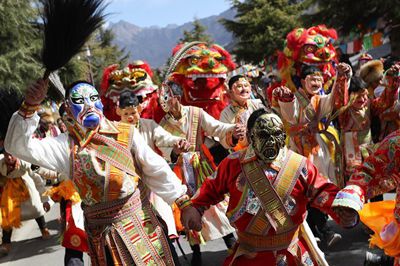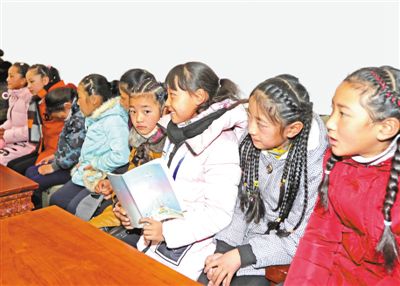|
3. Public Services and Civil Projects In old Tibet there were only three government-run organizations of Tibetan medicine and a small number of private clinics, all shabby and with poor facilities. The total number of medical workers then was less than 400, averaging 0.4 for every 1,000 Tibetan people. In view of such a situation, the state has carried out a special health care policy in Tibet since the democratic reform in 1959. In cities and towns residents have personal medical insurance accounts with the individual contributing a certain percentage of his/her monthly salary to the account and his/her employer contributing some more depending on the individual's share. In farming and pastoral areas people enjoy free medical care. During the past 50 years, the state has allocated more than 1.8 billion yuan of special funds to develop the health care system in Tibet, and the medical subsidies for Tibetan farmers and herdsmen have exceeded 20 million yuan every year. At the end of 2008, there were 1,339 medical care organizations in Tibet, an increase of nearly 20 times over 1959; the number of hospital beds had increased to 7,127 from 480 in 1959, and the number of hospital beds for every 1,000 residents was 2.5, or 2.11 beds more than in 1959. The number of medical workers increased from 791 in 1959 to 9,098 in 2008, and the number of medical workers for every 1,000 residents was 3.05, or 2.41 more than in 1959. The numbers of hospital beds and medical workers for every 1,000 residents in Tibet were both higher than the national average, and were also higher than the average level of middle-income countries, as shown in Fig. 14.[16]
In 2008 there were 80 disease and epidemic prevention and control centers and organizations, and 58 women and children's health care hospitals and stations. Serious epidemic diseases like tuberculosis, iodine deficiency disorders and Kaschin-Beck disease had been effectively controlled. Iodized salt had been introduced to 66 percent of the total population of Tibet. At present, more than 97 percent of Tibetan children have had vaccinations against serious ailments. Before the democratic reform, more than 90 percent of Tibet's serfs had no private housing. After the democratic reform, the farmers and herdsmen gradually obtained houses of their own, but the per capita housing area was still small and the living conditions poor. Since the 10th Five-Year Plan period (2001-2005), the People's Government of the Tibet Autonomous Region has actively invested in housing in farming and pastoral areas, and worked on key projects like rebuilding farmers' houses and constructing settlement centers for nomadic herdsmen. About 100,000 of the 400,000 rural households of farmers have rebuilt or newly built their houses. The living conditions of some farmers and herdsmen have been improved to a considerable extent. In early 2006, the regional government started across the region the "comfortable housing project" for farmers and herdsmen. During the11th Five-Year Plan period (2006-2010), the regional government will complete building new houses or rebuilding houses for 219,800 households, involving 1,252,000 farmers and herdsmen. It is projected that over 80 percent of Tibetan farmers and herdsmen will be settled in safe and comfortable houses in five years. By the end of 2008, the region had invested more than seven billion yuan to help 200,000 families, or about one million farmers and herdsmen to build new houses. The per capita housing area for farmers and herdsmen has now reached 22.83 sq m, close to the national average. For a long period of time, the poor drinking water quality for both people and livestock held back the rural economic development of Tibet. But since the peaceful liberation of Tibet in 1951 the central government has taken various measures to solve that problem. Especially since the 10th Five-Year Plan period (2001-2005), the central government has increased its investment in the construction of safe drinking water projects in Tibet's farming and pastoral areas, allocating close to 500 million yuan in total for such projects in all 74 counties in Tibet. During the 10th Five-Year Plan period, 4,525 safe drinking water projects of various types were completed across the region, benefiting 580,000 people and 5.56 million head of livestock which previously had difficulty obtaining safe drinking water, and making drinking water safe for another 200,000 people. Now the percentage of farmers and herdsmen who have running water available has increased from 12 percent in 2000 to 29 percent. In 2005, a rural safe drinking water program was initiated in Tibet, and the central government also increased the investment in related projects. By the end of 2007, the total funds invested in the program had reached 450 million yuan, and over 600,000 farmers and herdsmen in Tibet were provided with safe drinking water. While constructing the safe drinking water projects, the government has given priority to comfortable housing project sites, areas suffering from high arsenic or fluorine contamination in the water or Kaschin-Beck disease, border areas and areas inhabited by ethnic minorities with smaller populations. It is planned that safe drinking water will be provided in all farming and pastoral areas in Tibet by the end of 2010.
Owing to the natural conditions and climate, and the deficiency of fossil fuels in Tibet, the local people used to use firewood as their major fuel source. The use of firewood, as well as manure and straw in great amount has an unfavorable impact on the ecosystem and environmental protection in Tibet. Since 1980, the central and regional governments have taken measures to solve the problem of alternative energy sources, establishing successively a solar energy research institution, methane energy research institution and some other related institutions. In 2008, based on scientific evidence, the regional government began carrying out the alternative energy strategy, earmarking 5.2 billion yuan to develop new energy sources like methane and solar power, and by taking advantage of the opportunity to set up a new housing structure coordinating housing, energy use and manure disposal. |
- Home
- News |Tibet |Exclusive |China |World |Other Tibetan-Inhabited Area |Tibet through the Eyes of Foreigners |Related News
- Documents |White Papers |Others
- Photo |Politics |Economy & Society |Culture & Religion |Human & Nature |Beautiful Tibet |Other Tibetan-Inhabited Area |Exchanges |Related
- Video |News |Documentary |Micro-Video |Entertainment
- Art
- Tourism
- In Focus
- About Tibet







